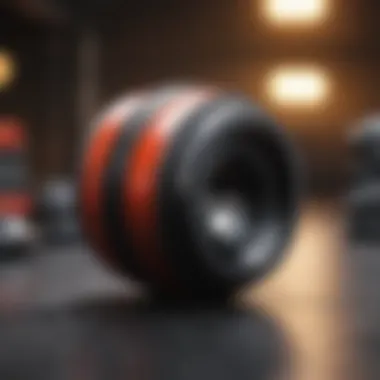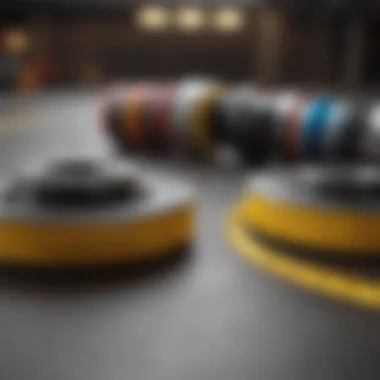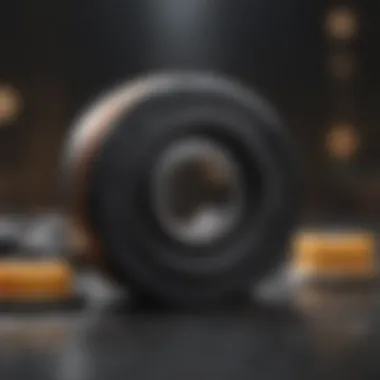Understanding Rubber Bushing Size Charts in Automotive


Intro
When dealing with automotive components, understanding rubber bushing size charts becomes crucial. Rubber bushings play key roles in absorbing vibrations and allowing for movement in various parts. Misjudging their size can have a detrimental effect on a vehicle’s performance and safety. Thus, having a grasp on the intricacies of these charts is significant for any automotive enthusiast or professional. The process of finding the correct rubber bushing involves identifying the right fitments for specific vehicle models, as well as understanding different types of bushings and their applications.
Importance of Proper Sizing
When rubber bushings are not correctly sized, it can lead to numerous issues. An improper fit may cause an increase in noise, reduced handling capabilities, and even accelerated wear on suspension components. Over time, these problems can necessitate costly repairs or replacements.
Additionally, establishing a right fit is necessary for ensuring safety during driving. Bushings take on various responsibilities depending on their placement within the vehicle. For instance, suspension bushings need to maintain stability during cornering while engine bushings must effectively reduce vibrations. Therefore, accurately understanding bushing size charts not only optimizes performance but also extends component lifespan.
Types of Rubber Bushings
Understanding the bushing options available provides the foundation for effective selection. The most common types include:
- Suspension Bushings: Located in the suspension system, these bushings absorb shocks and vibrations, enhancing ride comfort.
- Engine Mount Bushings: They secure the engine to the chassis and dampen vibrations.
- Traction Bar Bushings: These support adjustable setups in performance vehicles and reduce unwanted movement.
Identifying these parts clearly aids in selecting the right size and type, working with given vehicle specifications.
Industry Standards
Navigating size charts makes understanding industry standards essential. Each manufacturer follows specific dimensions and technical specifications. Connecting with reputable sources ensures accuracy whether looking at specifications or interpreting size charts. Familiarining oneself with standards helps develop informed decision-making during repairs or upgrades.
Reading Size Charts
Size charts can be integral tools provided by manufacturers. These charts typically contain:
- Measurement units (usually millimeters or inches)
- Bushing width and height
- Flange sizes and configurations
- Additional mechanical tolerances
Learning to read charts takes practice, yet knowing how to derive correct bushing specifications proves invaluable.
Common Applications of Rubber Bushings
Different rubber bushings serve unique uses across various applications. Understanding these will ultimately tailor selections to needs more effectively. Some vital applications involve:


- General vehicle maintenance: contributes to overall durability and performance.
- Custom builds and performance vehicles: a focus on enhanced handling and reduced vibrations ensures reliable operation.
- Restorations: Original specifications must be met for optimal historic significance provided by accurately sized bushings.
A solid foundation in rubber bushing size charts facilitates suitable applications, aiding effective project resolutions and improving knowledge within the automotive sphere.
It's important to align rubber bushing specifications with vehicle requirements to maintain performance integrity.
As the automotive field evolves, so too with rubber bushing standards. Reviewing updates reduces discrepancies between needs and solutions. Staying informed will elevate approachability to technical challenges presented by measurement misalignment.
Prelude to Rubber Bushings
In the realm of automotive engineering, rubber bushings play a crucial role in ensuring performance and comfort. Understanding their function and application can greatly influence vehicle maintenance and performance outcomes. Rubber bushings are designed to dampen vibrations and accommodate free movement of various suspensions and components. This ongoing necessity necessitates an examination of the key elements driving their design, usage, and evolution, elucidating their significance in both market longevity and automotive engineering stability.
Definition and Purpose
Rubber bushings are flexible components made from rubber and generally inserted into mechanical assemblies. Their primary function is to absorb shock and noise, providing a smoother ride while maintaining spatial control in suspensions and other moving parts. They also minimize friction between parts and prevent unwanted wear, effectively extending the life of both the bushing and adjacent components. In summary, they serve as a mediator that mitigates raw mechanical forces by converting them into manageable tendencies.
Some notable functions include:
- Vibration damping: Bushings are engineered to reduce the levels of vibrational energy transmitted through the vehicles' frame.
- Alignment control: They uphold the geometric precision of parts enduring strain and movement.
- Noise reduction: These components substantially lessen sound pollution within the cabin.
- Movement flex: Aids in accommodating the relative mobility of connected parts across multiple axes.
Historical Development
The inception of rubber bushings dates back to early 20th century automotive designs. Initially crafted from traditional materials, they evolved to address increasing demands for comfort and durability in vehicle design. The introduction of synthetic rubber in the mid-1900s revolutionized this area of automotive engineering. Synthetic compounds provided enhanced temperature response and resilience to degradation, thus, allowing manufacturers to create bushings that could withstand more significant stress.
Over the years, technological advancements spurred innovative designs, including polyurethane bushings which present heightened stiffness and longevity. Additionally, the incorporation of various fillers and additives into rubber formulations has taken place, rendering advancements such as better load capacities and improved performance at extreme temperatures. Such historical context plays a vital role in understanding contemporary applications and the extensive development of rubber bushings used today.
Understanding both the defining characteristics and historical context of rubber bushings allows for an informed approach to selecting the fitting component within specific automotive applications.
Types of Rubber Bushings
The exploration of rubber bushing types provides a critical framework for understanding their application in automotive systems. Different types of bushings cater to various needs within the vehicle, affecting performance and durability. Selecting the appropriate bushing type plays a significant role in how well a vehicle handles and absorbs shock. Each type has unique characteristics and benefits, guiding users toward more informed decisions in their vehicle maintenance or upgrades.
Standard Bushings
Standard rubber bushings are widely used in automotive applications. They are typically made of natural rubber which offers flexibility and sufficient vibration dampening.


The common uses of standard bushings include suspension systems and component jointing. Their fundamental benefit lies in the combination of affordability and performance.
- Key features of standard rubber bushings include:
- Good shock absorption
- Cost-effective production
- Easy installation
However, their performance might fade under harsh environments or prolonged usage. While they work efficiently in most conditions, they may not match the performance characteristics of higher-quality materials. This prompts interested professionals to evaluate where standard bushings fit into their overall vehicle design or repairs.
Polyurethane Bushings
Polyurethane bushings present a premium alternative with heightened durability and stability. Unlike standard rubber, polyurethane materials bring greater resistance to wear and environmental degradation. Such characteristics render them appealing to performance enthusiasts and those seeking enhanced vehicle handling.
Using a firmer compound confers more dimensional strength, minimizing compression under load. Tak benefits include:
- Increased control during steering
- Enhanced load transmission
- Reduced deflection(source)
Nevertheless, it's worth mentioning that they are often noisier and could transmit more vibration than their rubber counterparts. Driver preferences and driving conditions thus influence the decision-making for choosing polyurethane bushings.
Specialty Bushings
Specialty bushings are custom-engineered components that can address specific situations or vehicle criteria. These bushings fill tailored niche roles in custom builds or performance applications, which standard types may not satisfy. Specialty bushings may include products made from elastomeric blends or innovative compositions designed for unique performance and environmental conditions.
Consider these aspects while evaluating specialty bushings:
- Tailored specifications
- Advanced material properties
- Compatibility with specialized automotive systems
Investing in specialty bushings may require thorough assessments. Companies often conduct detailed consultations before finalizing product recommendations, given their targeted nature. For automotive enthusiasts or experts, understanding these types leads to well-rounded decision-making applicable across a spectrum of performance needs.
As these types unfold, it’s essential to associate them properly with the desired outcome in enhancing vehicle performance and user satisfaction.
Importance of Accurate Sizing
Rubber bushings are crucial components in vehicle dynamics, serving various purposes that directly influence performance, comfort, and safety. Accurate sizing remains essential due to a number of factors that automotive enthusiasts and professionals must consider when selecting bushings for their applications. Proper sizing ensures integrity in system performance, allowing for harmonious functioning of mechanical assemblies while contributing to vehicle longevity.


Impacts on Performance
When bushings are sized correctly, they allow for adequate fluidity of movement. This optimal fit improves performance in suspension systems by enhancing handling and steering response. Typically, well-fitted rubber bushings absorb vibrations efficiently, mitigating noise and improving overall ride comfort. This plays an important role in performance handling, as the driver experiences better feedback and road feel.
In contrast, oversized or undersized bushings can drastically alter vehicle dynamics. An unfit rubber bushing can restrict crucial movement between components. Not to mention, this restriction generates excessive stress that can lead to premature wear and failure. Often, overlooked wear leads to serious screw-ups in performance, causing part discomfort. On the other side, too much clearance might lead to rattles and instability. Eassy right-sizing aligns these vital factors.Redundant forces on components lead to knock on dashboards and a considerable decrease in driver confidence while navigating across various conditions.
Effects of Incorrect Sizing
Mistakes in sizing rubber bushings can have long-reaching implications. Firstly, incorrect sizing invoves labor-intensive adjustments post installation, increasing physical workloads significantly. Over time, using improperly sized bushings might complicate replacement needs. Moreover, it risks compromising safety parameters.
According to industry standards, a significant focus should target bushing design utilization, often integrating precise measurements. One should pay closer attention to the rubber's endurance against competing materials share influence consequences when components do not mesh properly.Joining this with inversion factors during production can negate the paramount purpose of rubber bushings.
Key points to recognize when sizing include:
- Misalignment effects such as reduced suspension capacity or excessive tire wear.
- Increased squeaking sounds indicating the onset of deterioration or stress fractures.
- Elevated susceptibility to cracking within the rubber, leading to eventual system fatigue.
Hence, embracing accurate sizing minimizes operational failures, extends the lifespan of vehicle components and ultimately retains the value of their investment.
How to Read Rubber Bushing Size Charts
Reading rubber bushing size charts is essential for those seeking to understand the various specifications and applications relevant to their vehicles. The right fitment plays a significant role in achieving optimal performance and longevity of automotive systems. Being familiar with size charts can aid in selecting the appropriate rubber bushings, as well as treating common problems resulting from misalignment or incorrect sizes. This section will break down how these charts can be navigated, highlighting key measurements and standards involved in the process.
Understanding Measurements
When analyzing rubber bushing size charts, several measurements need consideration. Comprehensive knowledge of these measurements is vital to ensure that the bushings fit properly within the system. The most common measurements include the outer diameter, inner diameter, and overall length of the bushing.
- Outer Diameter (OD): This is the exterior width of the bushing. It prevents unintended movement within the assembly.
- Inner Diameter (ID): The inner dimension matches the vehicle’s specifications. Accurate inner diameter ensures it fits snugly onto components without slipping off.
- Overall Length (OL): This factor narrows down how much space the bushing occupies. Accurate overall length aids in preventing issues like excess vibrations or misalignments.
Most charts will present these measurements in a systematic format, offering clarity on the sizing.
Common Units of Measurement
Different industries follow varying measurement systems. Therefore, rubber bushing size charts may present relevant dimensions in distinct units. Generally, the metric and imperial systems are the most prevalent.
- Metric Units: These units are often expressed in millimeters. A good understanding of the metric system enhances compatibility with many international automotive standards.
- Imperial Units: In North America, sizes are often listed in inches. Knowing how to convert between metric and imperial systems is sometimes necessary when referring to local suppliers.
Moreover, when reading rubber bushing size charts, typical tolerances may also be noted. Here’s an example:
OD (mm) | ID (mm) | OL (mm) | Tolerance 20 | 10 | 30 | ±0.2







